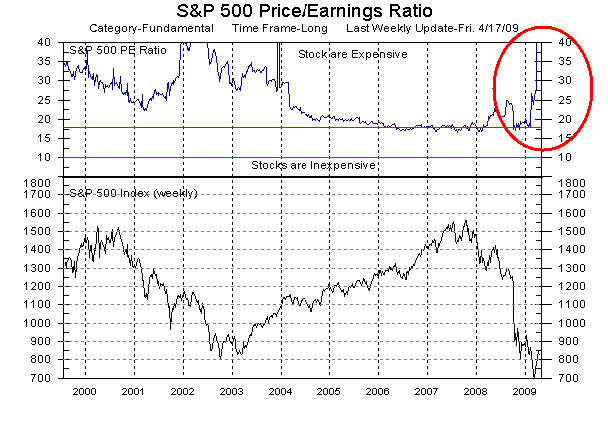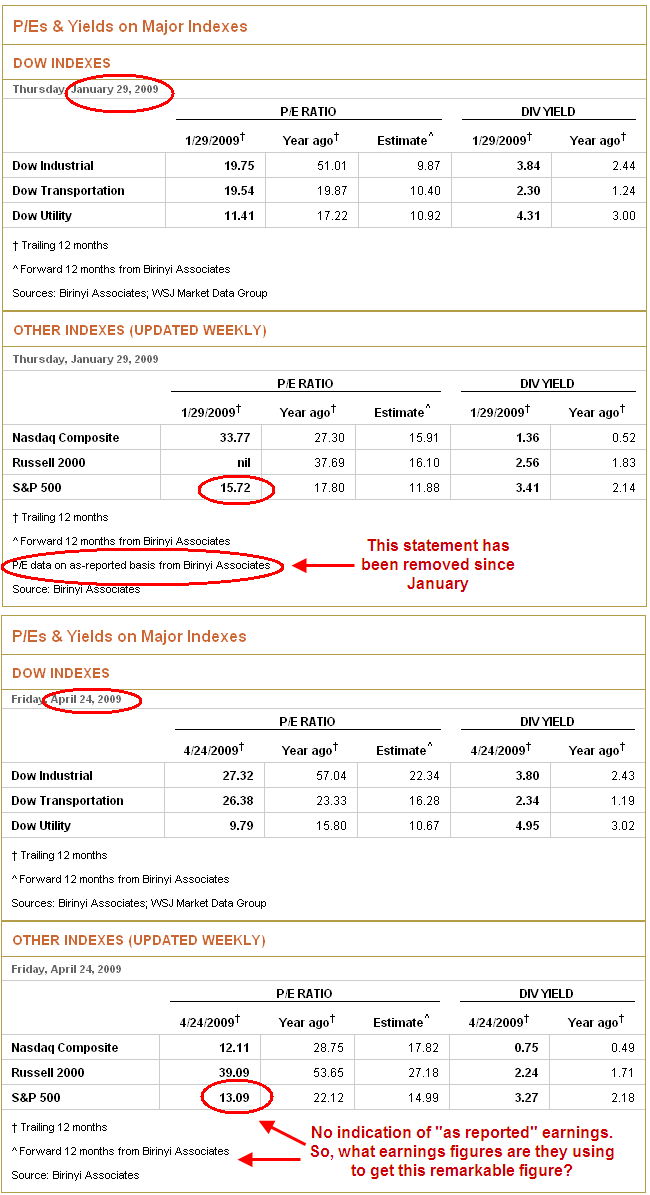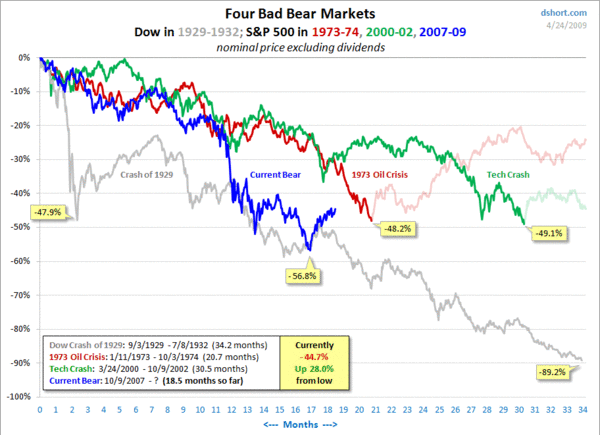
Dynamics

|
Generational Dynamics |
| Forecasting America's Destiny ... and the World's | |
| HOME WEB LOG COUNTRY WIKI COMMENT FORUM DOWNLOADS ABOUT | |
Their figures don't make sense, and they differ from everyone else's.
I've complained many dozens of times on this web site for several years that journalists and analysts constantly lie about price/earnings ratios (also called "valuations"), in order to support the stock market bubble. But what's going on at the Wall Street Journal really takes the cake. These people have no shame.
Last month I wrote "Analysts and journalists freak out as Q4 2008 earnings turn negative." In that article, I provided several different sources for current price/earnings ratios, including the Decision Point Earnings Summary, the Comstock Funds page, and a spreadsheet file from Standard & Poors.
Let's take a look at the latest figures from the official Standard & Poors spreadsheet:
Estimated Price/Earnings ratios based on
Period Operating Earnings "As reported" earnings
------- ------------------ ----------------------
Q4 2010 11.21 24.07
Q3 2010 11.77 24.58
Q2 2010 12.36 25.38
Q1 2010 13.17 27.57
Q4 2009 14.11 29.82
Q3 2009 19.73 -464.52
Q2 2009 19.95 1932.00
Q1 2009 18.82 127.64
As I wrote last month, "operating earnings" is essentially a meaningless figure, supposedly equal to earnings, but not counting so-called one-time expenses. Since writing down toxic assets is a "one-time expense," the tens of trillions of dollars in losses from toxic assets are being ignored in "operating earnings," although their fraudulent nominal value was of course included with "earnings" during the credit bubble.
The only valid values for P/E ratios are based on "as reported" earnings -- that is earnings that public corporations report every quarter, following very strict accounting rules.
The figures 127.64, 1932.00 and -462.52 look like errors, but they're not. They're based on the previous year's earnings ("12 month trailing earnings"). Earnings turned negative in Q4, so they're small but still positive for the entire past year. By Q3 of this year, it's estimated that earnings for the trailing year will be negative, so the P/E ratio turns negative.
This should be a really huge news story, especially for WSJ and CNBC and for other financial media. Instead, they're doing worse than ignoring it; they're making up numbers to hide from the public what's going on.
I would also add that the principal financial bloggers are ignoring this as well. I don't follow all of these blogs every day, but I've never seen any mention of this huge story on Nouriel Roubini's blog, Michael ("Mish") Shedlock's blog, the Calculated Risk blog, the MinyanVille blog, Yves Smith's Naked Capitalism blog, or the Financial Times alphaville blog.
One way for journalists and analysts to "cheat" is to use made-up "operating earnings," and that's what a lot of them have been doing. But you can see from the above table that the current P/E is 19.95 for Q2, based on current S&P 500 index of about 850.
As we'll show below, the Wall Street Journal is reporting a current P/E of 13.09. Well, where the hell did that number come from?
Before going into that, let's see what a couple of other financial firms are reporting.
First, let's take a look at the following chart. There's a price/earnings ratio chart at the bottom of this web site's home page, and it gets updated automatically every week. Here's last Friday's version of the chart:
 |
If you look at the far right side of this chart, where the red circle is, you can see a huge spike in the last weeks, sending the P/E ratio off the chart, up above 40.
Next, let's take a look at the chart from the Decision Point Earnings Summary:
 |
Once again, if you look at the area of the red circle, you can see the huge spike, off the chart.
So it's not as if everyone is following WSJ's lead.
Now let's look at what WSJ has been doing. And I'd like to thank "Freddyv" in the Generational Dynamics forum. He has been following this issue and working on it for several months, and much of this analysis comes from him.
Let's look at the following two charts from the Wall Street Journal site:
 |
The top chart, from January 29, 2009, shows an S&P 500 ratio of 15.72. Supposedly, that figure is: "P/E data on as-reported basis from Birinyi Associates." But that figure is already a lie. If you look at the above two charts from MarketGauge and Decision Point, you can see the P/E ratio was above 18 all year, and has been well above 15 for ten years.
There's no way that the January 29 figure is based on "as-reported" earnings, as the chart claims. In fact, even "operating earnings" don't justify that figure, so I have no idea what figures they made up to justify that figure.
But it gets worse in the latest chart, for April 24, 2009, shown on the bottom.
First of all, notice that the claim "P/E data on as-reported basis from Birinyi Associates" has been removed. "Freddyv" says that they removed that claim when he wrote to the WSJ demanding an explanation. The WSJ didn't respond to him, of course, but they did remove this obvious lie from their web site.
But even if they're using "operating earnings," where the hell did 13.09 come from? The official numbers from Standard & Poors are much higher than that, as we saw above.
Not only that, 13.09 is lower than the January 29 figure, 15.72, but the S&P 500 index is almost the same. How is that possible?
There is no way to justify these figures rationally. So where did they come from?
Well, WSJ gets the figures from Birinyi Associates, and we can get a clue from the Birinyi Associates web site. Here's what it says right at the top of the home page:
Birinyi Associates is a stock market research and money management firm. Our approach is to understand the psychology and history of the market, and most importantly the actions of investors. Much of our effort involves Money Flows, or what has traditionally been called ticker tape analysis.
Our daily, weekly and monthly research provides detailed market analysis as well as individual stock picks to individual and institutional investors. From our Chart of the Day to our Reminiscences newsletter, we believe that all of our services will prove to be a profitable investment of your time.
Please take the Birinyi Tour to learn which service is right for you and Subscribe today!"
I'm sorry, Dear Reader, but I can't stop laughing every time I read this. The Wall Street Journal, CNBC, Bloomberg News, and financial journalism in general have sunk so low that they actually depend on garbage like this. I'll make the same remark that I made in "Vile 'teabagging' jokes signal the deterioration of CNN and NBC news:" I don't see how the financial journalists could become any worse (though I'm sure they'll find a way).
So, apparently, Birinyi Associates do not depend on actual figures to reach their conclusions. They're a touchy-feely group of analysts. They analyze the psychology of the investor, possibly confirm their estimates with a handy Ouija Board and the local soothsayer, and pass those numbers on to the Wall Street Journal for publication. Incredible!!! They're an embarassment to the financial community and to the financial journalism community, but they're the norm today.
And so, Dear Reader, that's how the Wall Street Journal arrived at the P/E ratio value of 13.09.
And that brings us back to the question that everyone wants an answer to: How long will the current stock market rally last?
As I wrote last month, the stock market fell 90% from 1929 to 1932, but during that three year period, there were numerous rallies, one as long as five months. So the current rally is not exceptional, even in the current worsening financial crisis. But how long will it last?
We can get a clue by comparing today's stock market fall to the one from 1929 to 1932. Here's a chart from dshort.com that compares them:
 |
In the above chart, compare the period 1929-32 (shown in grey) to the period since October 2007 (shown in blue). In particular, if you look at the current rally (the end of the blue line), it appears to be leveling off, which indicates that the rally is just about at an end. If you compare the current rally with previous rallies in 2008 and in 1930-32, you can see that if history repeats itself, then we can expect a sharp plunge in the next few weeks.
For more thoughts about the path of the stock market today, check out "Timing the Depression" on Matt Stiles' Futronomics blog. This article has some of the latest charts showing the worldwide economic collapse.
But whether the rally ends now or later, it must end because corporate earnings are crashing, and because price/earnings ratios are going through the roof. This is not a "maybe," and this is not something that will happen unless President Obama does "X". There is nothing that can be done.
This shameful episode of lying by the WSJ about P/E ratios is nothing new. I've been giving similar examples for years.
This is just one more example of why you'll never get a straight answer about anything from WSJ or CNBC or any of the other financial media, or even from the financial bloggers, even from the "doom and gloom" Nouriel Roubini.
Once again, I would like to warn web site readers against the easy seduction of believing that "the worst is over," that "there'll be nothing worse than long recession" and that "there won't be a panic."
There is absolutely no possibility that any of these things are true. There is no theoretical support for any of these views, and there are no historical examples of these scenarios. The stock market will fall below Dow 3000 with 100% certainty. Any belief otherwise is simply wishful thinking.
Nothing has changed. The Law of Mean Reversion has not been repealed by the Wall Street Journal or the Obama administration. Since the stock market has been far overpriced since 1995, as I described in "How to compute the 'real value' of the stock market," and since the Law of Mean Reversion still applies, there must still a generational panic and crash in store.
It could come next week, next month or thereafter, but it's coming with absolute certainty, and nothing that has happened or is being planned has any possibility of stopping it, no matter how many manufactured numbers the Wall Street Journal publishes.
(Comments: For reader comments, questions and discussion,
see the Financial Topics thread of the Generational Dynamics forum. Read
the entire thread for discussions on how to protect your money.)
(26-Apr-2009)
Permanent Link
Receive daily World View columns by e-mail
Donate to Generational Dynamics via PayPal
Web Log Summary - 2016
Web Log Summary - 2015
Web Log Summary - 2014
Web Log Summary - 2013
Web Log Summary - 2012
Web Log Summary - 2011
Web Log Summary - 2010
Web Log Summary - 2009
Web Log Summary - 2008
Web Log Summary - 2007
Web Log Summary - 2006
Web Log Summary - 2005
Web Log Summary - 2004
Web Log - December, 2016
Web Log - November, 2016
Web Log - October, 2016
Web Log - September, 2016
Web Log - August, 2016
Web Log - July, 2016
Web Log - June, 2016
Web Log - May, 2016
Web Log - April, 2016
Web Log - March, 2016
Web Log - February, 2016
Web Log - January, 2016
Web Log - December, 2015
Web Log - November, 2015
Web Log - October, 2015
Web Log - September, 2015
Web Log - August, 2015
Web Log - July, 2015
Web Log - June, 2015
Web Log - May, 2015
Web Log - April, 2015
Web Log - March, 2015
Web Log - February, 2015
Web Log - January, 2015
Web Log - December, 2014
Web Log - November, 2014
Web Log - October, 2014
Web Log - September, 2014
Web Log - August, 2014
Web Log - July, 2014
Web Log - June, 2014
Web Log - May, 2014
Web Log - April, 2014
Web Log - March, 2014
Web Log - February, 2014
Web Log - January, 2014
Web Log - December, 2013
Web Log - November, 2013
Web Log - October, 2013
Web Log - September, 2013
Web Log - August, 2013
Web Log - July, 2013
Web Log - June, 2013
Web Log - May, 2013
Web Log - April, 2013
Web Log - March, 2013
Web Log - February, 2013
Web Log - January, 2013
Web Log - December, 2012
Web Log - November, 2012
Web Log - October, 2012
Web Log - September, 2012
Web Log - August, 2012
Web Log - July, 2012
Web Log - June, 2012
Web Log - May, 2012
Web Log - April, 2012
Web Log - March, 2012
Web Log - February, 2012
Web Log - January, 2012
Web Log - December, 2011
Web Log - November, 2011
Web Log - October, 2011
Web Log - September, 2011
Web Log - August, 2011
Web Log - July, 2011
Web Log - June, 2011
Web Log - May, 2011
Web Log - April, 2011
Web Log - March, 2011
Web Log - February, 2011
Web Log - January, 2011
Web Log - December, 2010
Web Log - November, 2010
Web Log - October, 2010
Web Log - September, 2010
Web Log - August, 2010
Web Log - July, 2010
Web Log - June, 2010
Web Log - May, 2010
Web Log - April, 2010
Web Log - March, 2010
Web Log - February, 2010
Web Log - January, 2010
Web Log - December, 2009
Web Log - November, 2009
Web Log - October, 2009
Web Log - September, 2009
Web Log - August, 2009
Web Log - July, 2009
Web Log - June, 2009
Web Log - May, 2009
Web Log - April, 2009
Web Log - March, 2009
Web Log - February, 2009
Web Log - January, 2009
Web Log - December, 2008
Web Log - November, 2008
Web Log - October, 2008
Web Log - September, 2008
Web Log - August, 2008
Web Log - July, 2008
Web Log - June, 2008
Web Log - May, 2008
Web Log - April, 2008
Web Log - March, 2008
Web Log - February, 2008
Web Log - January, 2008
Web Log - December, 2007
Web Log - November, 2007
Web Log - October, 2007
Web Log - September, 2007
Web Log - August, 2007
Web Log - July, 2007
Web Log - June, 2007
Web Log - May, 2007
Web Log - April, 2007
Web Log - March, 2007
Web Log - February, 2007
Web Log - January, 2007
Web Log - December, 2006
Web Log - November, 2006
Web Log - October, 2006
Web Log - September, 2006
Web Log - August, 2006
Web Log - July, 2006
Web Log - June, 2006
Web Log - May, 2006
Web Log - April, 2006
Web Log - March, 2006
Web Log - February, 2006
Web Log - January, 2006
Web Log - December, 2005
Web Log - November, 2005
Web Log - October, 2005
Web Log - September, 2005
Web Log - August, 2005
Web Log - July, 2005
Web Log - June, 2005
Web Log - May, 2005
Web Log - April, 2005
Web Log - March, 2005
Web Log - February, 2005
Web Log - January, 2005
Web Log - December, 2004
Web Log - November, 2004
Web Log - October, 2004
Web Log - September, 2004
Web Log - August, 2004
Web Log - July, 2004
Web Log - June, 2004